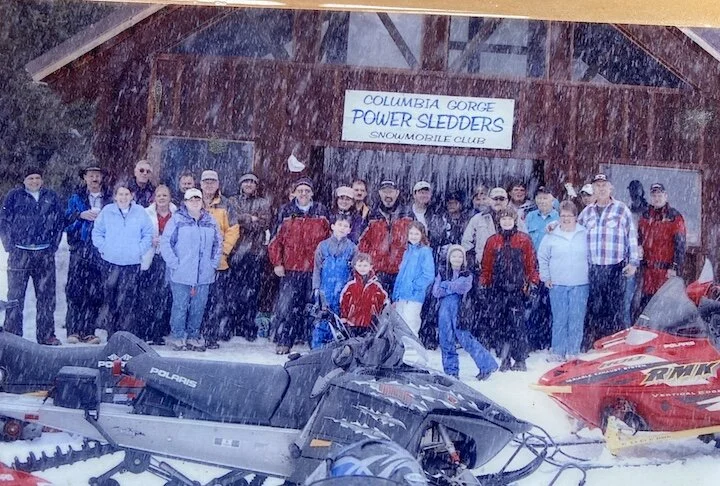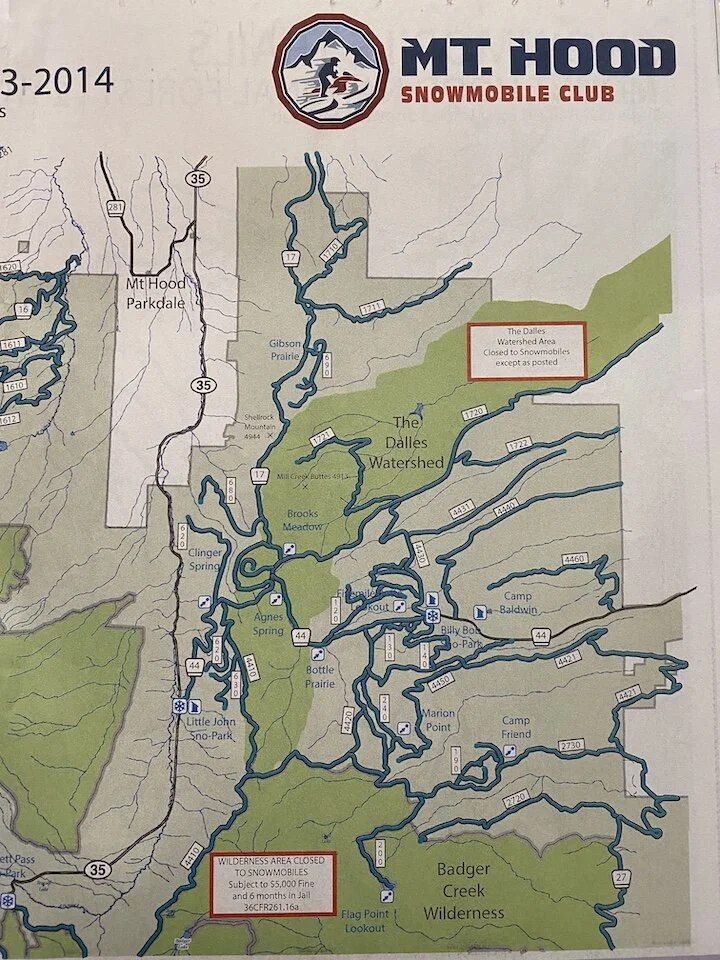Power Sledders Assist Police in Suspect Capture
Gary Conley and President John Vogel of Columbia Gorge Power Sledders are feeling alright with the new 2021 Tucker Sno-Cat with 300 horse power behind them. Used to groom trails and assist people, the Sno-Cat is the first new machine the volunteer group has had since its inception in 1984.
Snow and the people who chase it create their own kind of magic.
It was 5:34 a.m. on Feb. 26 when Dave Rogers got the call at his home on Seven-Mile Road.
A black Jeep crossed the line on Highway 197 and almost hit an Oregon State Police Trooper near Dufur and then led police on an 85-mile per hour chase that ended up on US Forest Service Road 4440 deep in the snow outside of Dufur in the Mount Hood National Forest.
Trooper Jonathon Swiger’s cruiser lacked the clearance to travel the snowy road.
He jumped in with a Wasco County Deputy Ray Randall who was assisting in the pursuit in his Sport Utility Vehicle. After five miles, the SUV got stuck too.
So, now Rogers and Ernie Smith were called in by dispatch. The groomers with the Columbia Gorge Power Sledders headed to Camp Baldwin and jumped in the new 2021 Tucker Sno-Cat.
It’s a 300 horsepower, four-track machine with metal cleats attached to rubber tracks.
It doesn’t get stuck.
On their way to assist the officers, Rogers and Smith came alongside the Black Jeep Wrangler.
It was stuck in the snow.
“We were riding along, and we got down there, and there was a gal by that Jeep. We rolled down the window a little bit and she asked us, ‘Can you guys help me out,’” Rogers said.
“We said yes, and we would be right back to pick her up.”
Rogers and Smith went and picked up officers Swiger and Randall - just another mile down the road - and then returned to the Jeep.
“She did not expect it,” Rogers said. “Them two guys flew out the machine guns drawn and screaming.”
Smith and Rogers remained in the cab.
“I did not want to get in a gunfight with a bunch of morons,” Rogers said.
Randall and Swiger arrested Jodie Lynn Speck, 52, of Madras on charges of attempting to elude, reckless endangering, reckless driving and parole violation. There was no one else in the Hertz-rented Jeep.
Then they all rode back together, a little conversation going back and forth, to a waiting police vehicle five miles down the road where Wasco County Deputy Nolan Ward was waiting to transport Speck to the regional jail in The Dalles.
“It’s better to just take your lumps right away,” Rogers said, noting the charges would not have been half as bad had Speck just pulled over, to begin with.
Smith and Rogers then towed the Police SUV back to where it had traction.
In the days that followed, unconfirmed reports of a large amount of methamphetamine and a firearm were located where the Jeep Wrangler had been driving.
While not all days present this much intrigue for the Columbia Gorge Power Sledders, the local group of about 30, have, no doubt, assisted many a stranded person while grooming trails and clearing trees.
Snow Bike or rocket ship?
The volunteers pay $45 in dues annually and put in thousands of volunteer hours combined to maintain the recreational area with some 145 miles of trail on the east side of Mount Hood. They groom 700 to 1,000 miles a year at 3 to 7 miles per hour. Essentially the work is between Billy Bob Sno-Park and Highway 35 in the National Forrest.
Snowmobilers, cross-country skiers, snowshoers and snow bike riders all benefit from their labor.
On Tuesday, current CG Power Sledder President John Vogel and member Gary Conely gave CCCNews a first-hand look at how they go about the business of grooming.
Ridiculously Beautiful - snowmobiling in the Mount Hood National Forrest has its own special reward. Piece quiet and alien beauty. Photo by Alvin Prasad
Vogel and Conely, who have been snowmobiling for decades, beamed about bringing family and friends out for rides in this winter wonderland. Kids, grandkids- it brings the family together for some excitement in the dead of winter. The grooming season is typically three months - Dec. 15 to March 15.
Vogel is a former Oregon State Snowmobile Association President and has long-standing in snowmobile recreation circles. Sometimes that helps the cause.
Last fall, Columbia Gorge Power Sledders received a brand new Sno-Cat after struggling for years with used equipment. The Oregon State Snowmobile Association and Oregon State Parks Recreational Trails Program spotted 97 percent of the $355,000 cost.
“It’s the first new Sno-Cat this club has had since it came into existence,” Vogel said, like a proud father.
The new machine with a rear rototiller to chop crispy snow is good for filling and smoothing the roads and trails. The backup camera is also a nice add-on when hemmed in by trees on a narrow trail.
Even better, multiple safety features prevent operators from making costly mistakes such as trying to go backwards while the rototiller and grooming drag are down and operating.
Why Grooming is Important
Conely and Vogel said four-wheel-drive vehicles often disobey the road closed signs and trek into the groomed trails of snow leaving deep ruts. Those ruts can easily flip an unsuspecting snowmobiler and send them careening into a nearby tree.
Rogers said there are Jeep groups that openly flaunt the rule, seeing it as a challenge to drive on the roads and then post their photos on the internet.
“They blackout their license plates and brag about being on our trail. They blatantly go out and do that and brag about it online,” he said.
Periodic checks on the trails are also important to ensure no one is stuck and in danger. Rescues and assists happen on occasion. Vogel, a Hood River County Reserve Deputy, is also part of the search and rescue team.
Font blade leveling, - John Vogel pears out the cabe of the the new Tucker Sno-Cat, which was manufactured in Medford, Ore.
The Club started in 1982 with Can-Do Attitude
One of the earlier Sno-Cats the club operated.
John Brookhouse was one of the original members of the Power Sledders. He tells stories of dragging bedsprings behind Ski Doo snowmobiles in the country in the early years.
“John’s worked on everybody’s snowmobile in the county for years,” Conely said.
That seems to be a thread throughout the volunteer group - mechanic skills and repairs on the fly have been invaluable through the years.
In the early days, the group bought a Tucker Sno-Cat with no engine and transmission. So they located and installed a used International Harvester 392 bus engine and transmission.
That kind of “can-do with what we’ve got” has seen the club last into its fourth decade.
Powder hound. Photo by Craig Martin
They’ve used donated equipment from other clubs and even put money from a Sno-Cat sale into a Cash Deposit, so the interest could pay for supplies when there was no funding.
When one of the wheels in a driver’s side front track failed on an older Sno-Cat, Vogel said Rogers came up with the idea to use a piece of guardrail to create a skid to limp the Sno-Cat back to the shop to make proper repairs.
Not easy. But it worked.
Volunteering
Power Sledders have volunteered for years building their own shop and maintaining the warming shelter at Billy Bob Sno-park.
Conely said he spent 22 years with the organization and grooming trails. Currently, there are eight groomers on deck - Dave Rogers, Charles Rogers, Cody Rogers, Mike Hannifan, Marv Hansen, Craig Martin, Ernie Smith and Vogel. They groom typically four days a week, attempting to avoid the busier Friday through Sunday if the weather allows.
Making it Nice for Everybody
Aerial shot of the Power Sledders at Billy Bob Sno Park
The club has also brought other nice improvements for the whole community.
Marty Donnell, applied for and received a $27,000 grant from Oregon State Parks to build the warming shelter at Billy Bob in 2003, Conely said. The club then added the concrete floor in 2019.
“We put the stain on it twice,” Conely added. They eliminated graffiti, fixed windows, supplied wood.
Billy Bob is a great jumping-off point for people wanting to get into deep snow or kids wanting to sled. And when you get too cold, just go into the warming shelter and sit next to the woodstove.
The group also grooms the sled hill at LIttle Jon Sno-Park off Highway 35.
They all get a bit of chainsaw work as well as they remove hundreds of trees from the trails.
“We’ve cut as many as 78 trees on High Prairie,” Rogers said. “We had to stop and cut each one out and remove it. It took us half a day to get through half of it.”
Why They Do It.
It’s challenging. It requires a unique set of skills in both machinery and understanding the sometimes frigid or deep snow conditions and confidence in the people they volunteer with.
“I do it for the people in the community,” said Rogers. “It made me feel good making something - a nice place to recreate that people can enjoy.”
It’s also insanely beautiful out there after a heavy snowfall and blue skies set in.
Flag Point Lookout
One Last Story
Rogers said he was driving the Sno-Cat into Flag Point Lookout several seasons back and he came across a baby stroller with skis attached to it laying in the snow. Nearby food and groceries were strewn about.
He said a couple with a young baby were staying at the lookout and it had snowed six feet overnight. They had abandoned a four-wheeler and made it in by snowmobile.
“We hauled them out of there,” he said. “We took the lady and baby in the Sno-Cat, and the guy drove the snowmobile back home behind us. It had a burned valve. They were stuck and had no communication. What would have happened if we would not have come along.”
Columbia Gorge Power Sledders in a group shot a few years back.
Here’s a map of the roads and trails Power Sledder volunteers maintain and groom. It’s a 145 miles worth of blood sweat and tears - and maybe a little fun along the way.










